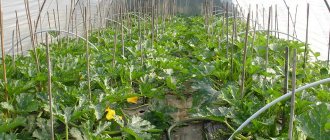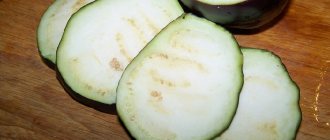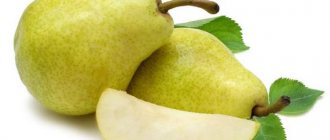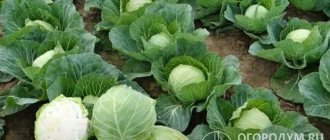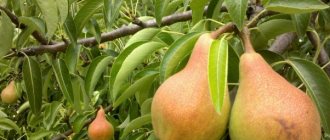The winter pear variety “Nika”, developed relatively recently, has already become widespread due to its frost resistance, high yield and excellent taste. The variety, created for cultivation in the middle zone, demonstrated excellent survival rate in the northern regions of Russia. Compact spherical trees are undemanding in care, and their large, dense fruits tolerate transportation well and can be stored until mid-winter.
High-yielding "Nika" is successfully grown both on small plots and on large farms
For ease of reference, the main characteristics of the variety are presented in the table:
| Parameter | Characteristic |
| Culture | Pear (Pyrus communis L.) |
| Variety | "Nika" |
| Tree height | Medium height: up to 3-4 m |
| Precociousness | Average: from 4-6 years after planting |
| Timing of fruit ripening to the stage of removable (technical) ripeness | Early autumn: second ten days of September |
| Period of consumption (storage) | Until the end of December - mid-January |
| Type of fruiting | Mixed: on ringlets and spears, partly on fruit twigs |
| Fruit weight | Average: 140-200 g |
| Productivity | Regular, high: 80-150 kg per tree (according to the results of field tests - 154 c/ha) |
| Appearance of fruits | The shape is regular, truncated-conical. The skin is medium thick, smooth, oily, with a waxy coating. The color of the peel during the period of removable ripeness: the main color is greenish, the outer color is blurred, red; during the period of consumer maturity it becomes light yellow with a brownish-red blush over most of the fruit. Subcutaneous dots are large, green, and clearly visible. The peduncle is medium in size, curved, oblique. The funnel is small, narrow, with an open cup and a shallow wide saucer |
| Pulp | Creamy, tender, medium-bodied, semi-buttery, fine-grained, juicy |
| Tasting assessment of taste qualities | 4.4-4.5 points (out of 5) – the taste is sweet and sour, without astringency and granulation, with a pleasant aroma |
| Purpose of fruits | Dessert (universal): intended for fresh consumption, preparation of various dishes and preservation |
| Sustainability | Has high winter hardiness (up to −38 ℃), immunity to fungal diseases (scab and septoria) |
| Year of inclusion in the State Register of the Russian Federation | 2002 |
| Recommended growing regions | Central Black Earth (5) |
| Originator/patent holder | Federal State Budgetary Institution "Federal Scientific Center named after I.V. Michurin" (Tambov region) |
History of selection
The variety is considered relatively new. It was developed in 2002, and later it was included in the Russian state register. At the moment it is grown in the Black Earth Region. A group of breeders from the Michurin Agricultural Institute worked on its breeding. Nika was obtained by crossing the Talgar Beauty and Daughter of the Dawn varieties.
What type of pear is it?
Pear "Nika" is a winter variety with high frost resistance, down to -38°C. The fruits have the ability to be stored for a long time. The variety is universal in its purpose.
Origin and zoning
A variety of domestic selection, bred at the State Scientific Institution VNIIGiSPR named after. I.V. Michurin by a group of scientists led by Professor S.P. Yakovlev. Obtained as a result of crossing the “Talgar Beauty”, from which it inherited frost resistance, drought resistance and large fruit, with the “Daughter of the Dawn” variety, characterized by high yield and aroma of fruits. “Nika” was created for cultivation in central Russia and more northern regions, zoned in the regions of the Central Black Earth Region, and since 2002 included in the State Register and patented by the originator.
One of the parent forms for “Nika” was the “Talgar Beauty” (pictured)
“Talgar Beauty” was obtained in Kazakhstan on the basis of the Research Institute of Fruit Growing and Viticulture by breeder A. N. Katseiko in 1960 by selecting seedlings from seeds from the free pollination of the Belgian variety “Forest Beauty”. Zoned in the North Caucasus region, widespread in the Stavropol and Krasnodar Territories, as well as in Ukraine. It is highly valued by amateur gardeners for the beautiful appearance of the fruits, their sweet caramel taste and rich aroma.
“Nika” successfully passed frost resistance tests: when the temperature in artificial conditions dropped to −38 ℃, the bark and cambium did not freeze, and xylem damage amounted to 0.6 points. As practice shows, even in the northern regions only minor freezing is observed, after which the trees quickly recover without a significant decrease in yield.
Description of the Nika pear variety
The tree is medium-sized in size. It has a ball-shaped crown with sparse fused skeletal branches. Fruiting occurs both on annual shoots and on perennial overgrowing branches.
The shoots are smooth, brown in color, medium in thickness and straight. There are a few lentils on the bark. Cone-shaped buds, slightly pointed at the ends. The oval leaves have a rich green color.
There is a characteristic serration on the sides and a short point at the end. The leaf plate is not very curved and has a smooth matte surface. The stipules resemble an awl, the petioles are medium-sized.
The Nika pear variety has large fruits, weighing up to 200 g. The shape is conical with truncation, regular. The skin looks smooth, oily, and has a waxy coating.
During the period of removable ripeness, the fruits have a greenish color with a blurred red, which is the integumentary color. Later, the pears acquire a more yellow tint with a brown outer color.
Short curved stalk, inclined at the base. The saucer is very small, mostly wide. Brown, cone-shaped seeds, medium in size, are stored in closed seed chambers.
The pulp of pears is very tender, practically free of grain and granulation.
The density is medium, slightly oily, creamy in color.
It has a pleasant sweet and sour taste, with slightly perceptible notes of nutmeg and without astringency.
The rating given during tasting was 4.5 points.
Description of the chemical composition of pear variety "Nika":
Composition Quantity
| Solids | 15,7% |
| Total sugars | 10,2% |
| Vitamin C | 6.2 mg/100g |
| Vitamin P | 122.0 mg/100g |
| Titratable acids | 0,40% |
You can see the Nika variety pear in more detail in the photo below:
Tree height
Nick's pear reaches a height of about 3 meters. Forms a spherical crown with sparse branching. Uniform growth of branches is a distinctive feature of the variety.
Description of the fruit
Pear fruits are cone-shaped. The size is large, weight is about 200 g. The skin is thin, dense, and when harvested it is green with red spots. The harvest is left to ripen for 2 weeks, after which the peel turns yellow. The pulp is cream-colored, dense, granular.
Important! Collected pears are stored for about 4 months, tolerate transportation well, are suitable for cultivation for sale, and are quickly sold out.
Calorie content
Nika pear fruits have high nutritional value and accumulate quite a lot of sugar. They contain (per 100 g):
- sugars – 10.2%;
- dry soluble substances – 15.7%;
- ascorbic acid – 6.2 mg;
- P-active compounds – 122 mg;
- titrated acids – 0.4%.
Taste
Nika's fruits can compete with famous southern varieties. The pulp of the fruit is juicy, oily, without grains (granulation). The taste is harmonious, sweet and sour with aromatic nutmeg notes, no pear astringency. Nika’s tasting score is 4.5 points, which is a high indicator.
Fruit size
"Nika" produces large conical fruits, weighing 150-200 grams. During the ripening period, the fruits are greenish in color with a red blush occupying most of the surface. By the period of consumer ripeness, pears turn yellow and the color acquires a brownish tint. The skin is smooth and shiny. The peduncle is small, curved, the funnel is shallow, the saucer is almost absent. The heart is small, the seeds are brown in closed chambers.
Usage
Nika is a universal variety. The fruits make excellent juices, jams and other preparations, but its best use is for dessert, fresh. Given the long shelf life, it is rational to store the fruits for vitamin “feeding” of the family in the autumn and winter.
Features of the plant, its pollination and fruiting
The tree is medium-sized (3-4 m), with sparse, rather thick, short skeletal branches that are firmly fused and extend from the trunk at an angle of about 60°. The crown is round in shape, sparse, evenly filled with branches of the second and third order, becoming sparser with age.
Compact, low trees are very convenient to harvest
The shoots are straight, smooth, hairless, of medium thickness, with brown bark and a small number of lentils. The fouling of fruit wood is moderate, and fruit formations are evenly and sparsely distributed along the entire length of the branch. Fruiting occurs on annual shoots and perennial overgrowing branches; ovaries are formed on ringlets and spears, and also partially on fruit twigs. With age, the tree becomes more spreading, the crown becomes bare, and the fruits become smaller. This can be prevented by regular pruning.
The leaves are medium-sized, oval-rounded, with a blunt base and a short-pointed tip. The leaf blade is rich green in color with a glossy sheen, smooth, slightly curved, with delicate venation and finely serrated serration along the edge. Stipules are subulate-shaped.
Snow-white flowers are collected in large inflorescences
"Nika" is partially self-fertile - growing separately, it shows only a third of its standard yield. The best pollinators for it are winter pear varieties, for example, “Duchess”, “Svetlyanka”, “Rogneda”, “Bere Russkaya”, “Williams” and “Feriya”, which bloom and bear fruit at similar times.
Early fruiting is assessed as average - the tree enters its productive age 4-6 years after planting. The variety demonstrates regular annual fruiting and high yield (about 154 c/ha or 80-150 kg per tree) with insignificant pre-harvest fruit shedding.
Rules for planting Nika pear
The pear has its own planting characteristics. It is necessary to take into account the place, time, choose the right seedling and carry out the manipulation according to a certain technology.
Deadlines
Pear trees can be planted correctly in spring and autumn. The best time for autumn planting is the first ten days of October. At this time, the seedling has time to take root before the onset of stable frosts.
The timing of spring planting depends on the condition of the seedling. Trees with an open root system must be planted before buds open, i.e. during the month of April. Seedlings in containers can be planted throughout May and even June.
Trees with blossoming leaves should be shaded in the first week after planting!
Basic moments
- You can plant a seedling in spring and autumn, but the best time is considered to be autumn. Choose a spacious and sunny area. Although the tree will not grow large, it should have enough space for proper development.
- The planting pit is prepared in advance. If planting is planned for spring, then in the fall you can prepare a hole. If you plan to plant a seedling in the autumn, then prepare the hole 7 days in advance.
- The planting hole should be 70 - 80 cm deep and at least a meter in diameter.
- It is necessary to add potassium, phosphorus and humus; other fertilizers are possible depending on the type of soil.
- Place a wooden peg next to the seedling and tie the young tree to it when planting.
- When planting, you should very carefully straighten the root shoots and only then fill in the soil, compacting it a little. The root collar should rise 5 - 6 cm above the ground surface.
- After planting, make a small mound in the circle around the trunk for watering.
- Apply 20 liters of water and then mulch the soil so that the moisture remains in the soil for a longer time. Humus is suitable for mulch.
Choosing a seedling
- Buy only from nurseries with a closed measles system. If the roots are open, then carefully inspect the plant: there should be no dry or rotten shoots, damage to the bark, or broken branches.
- The height of the seedling should be approximately 100 cm, and the root system should be well developed.
- The tree must have at least several vertical branches with stepsons.
- The best age is 2 years.
Site selection and preparation
First you need to take into account that the pear requires a well-lit area. Otherwise, there is a possibility of a decrease in the sugar content of the fruit and a decrease in yield. Despite the average size of the Nika pear, planting among other trees should be avoided. You need to decide on a place for planting in advance so that you don’t have to replant the plant later, especially since the pear tree doesn’t like it.
The pear does not tolerate stagnant water, so it is not planted in lowlands. Groundwater should be at least 2–2.5 m deep.
For the crop in question, sandy loam, gray forest, loamy or chernozem soils are considered the most suitable. It is better to start preparing the planting pit in the fall (October-November). During the winter, the earth will settle and be saturated with fertilizers.
Planting and care
- Landing The best time of year for planting pears is considered autumn. The location must be chosen sunny and very spacious. Although “Nika” is not a vigorous tree, it still requires a lot of space for the full development of fruiting.
After choosing a location, prepare a hole for planting. The tree cannot be planted right away; the hole must be prepared at least a week in advance.Its dimensions should correspond to one meter in diameter and about 78–80 cm in depth . Depending on the type of soil, potassium phosphate fertilizers and humus are added to the pit in the required proportions.
Before planting the seedling, a stake is driven into the hole, which should subsequently be raised 70–80 cm above the ground.Then you need to carefully lower the tree there, spreading the roots on the sides.
In this case, you need to ensure that the root collar protrudes 5–6 cm above the ground surface . After this, the hole is filled with the remaining earth.
A small ditch should be made around the tree, which will retain water from spreading when watering. After this, slowly water the seedling with two buckets of water and mulch it with humus.
- Watering A newly planted tree needs in abundant and frequent watering until its roots are completely established.
Then you need a tree water no more than three times during the summer, except in special weather conditions.ATTENTION: If the summer is dry and hot, then water the tree more often than usual.
You need to water the pear very carefully. She does not tolerate cold tap water or sudden watering. It is better to keep the water in barrels beforehand so that it has time to heat up.
Also, you should not pour a bucket of water under the tree at once, otherwise the roots will be washed away and the pear may die. Some gardeners dig a trench leading to the tree and pour water over it , which in this case flows slowly and steadily.
After watering, the soil around the pear needs to be loosened a little to avoid the formation of a crust on the surface. Loosening provides the roots with access to oxygen.
- Care and pruning
It is mistakenly believed that the planting process is the most important.
Equally important is proper care of a young tree. One of the stages of necessary care is pruning.A one-year-old tree is pruned so that it reaches a height of 45–50 cm. Thus, intensive growth of the lower branches is triggered.
When the tree reaches a certain size, usually at 4–5 years of age, the crown can be thinned and the branches can be shortened.
Thin out the crown for better access to sunlight, which pears love so much. Shortening the branches is necessary to form a regular and beautiful crown.
ATTENTION: Lack of pruning in “Nika” results in rapid exposure of the crown and small fruits.
Usually, all improperly growing and unnecessary branches are removed using sharp pruning shears. They cut down the branches into a ring so that there are no stumps left. The cutting areas must be treated with paint or garden putty .
The Nika pear does not require special shelter due to its high frost resistance. An exception may be in the form of covering the trunk for the winter and covering the roots with mulch and snow.
But such measures can be taken in areas with harsh climates.Fertilizers are applied only from the second year of planting the seedling. Peat and humus are mainly suitable for pears
They should be mixed with soil and poured into the trench around the tree during watering.
Caring for Nika's pear
The main thing is to follow the recommendations. There are several stages for a tree to take root and begin to actively develop and grow.
Watering
- Moisten the soil regularly until the seedling takes root. The soil should not be allowed to dry out.
- Subsequently, it is necessary to moisten the soil at least 3 times during the summer period, if planting was carried out in the spring.
- If the summer is hot and dry, then increase watering.
- Experienced gardeners recommend digging a small ditch towards the seedling and pouring water along it. So it will come in small portions. Because if you pour out all the liquid at once, you can wash away the soil near the root system, and the tree can die.
- Use settled water; cold watering is not recommended.
- After watering, be sure to loosen the soil around the planted tree so that air can reach the roots.
Top dressing
It is carried out only from the 2nd year after planting. Fertilizers are laid out in a circle around the trunk. Peat and humus are usually used. They should first be mixed with soil.
Crown formation
Crown pruning is very important for this variety. All dry, old branches need to be cut out. Young shoots must be shortened by 10-15 cm. When planting a pear, the branches of the young tree must immediately be shortened by about a third. Thanks to this technique, the crown will be better formed. Pruning should be done annually in the spring, before the buds open. Unnecessary shoots must be removed completely, leaving no stumps. If a tree is neglected, it will quickly begin to thin out and the fruits will become smaller.
Trimming
Planting is not the most important stage. Aftercare is equally important. Part of it is mandatory pruning.
- A year after planting, the upper parts of the shoots should be shortened to half a meter in height. After this procedure, the lower branches begin to actively grow.
- After 5 years, be sure to thin out the crown and also shorten the branches a little. In this case, the sun will come in the right amount; do not allow the crown to thicken.
- If you do not prune, the fruits become small, and the crown thins out over time.
- Perform pruning with disinfected and sharp pruning shears. Treat the cut areas with garden varnish or paint.
- After winter, sanitary pruning is done. It is very important and necessary to have time to remove all deep-growing shoots, weak and dry, broken, infected with viruses before the sap begins to flow.
Rejuvenation
Rejuvenation of the Nika pear is an important point in varietal agricultural technology.
The signal for rejuvenation is the crushing of fruits. Skeletal branches are cut into young branches, without leaving knots; the cuts are treated with garden varnish.
Preparing for the winter
Although many varieties of winter pears can withstand low temperatures, including Nika’s pear, it is still better to insulate it a little during the winter. To do this, the trunk must be wrapped in non-woven material or other insulation.
Possible difficulties during cultivation
Nika's pear is immune to most diseases and pests, but preventative treatment will not hurt it. The plant should be sprayed with pesticides before flowering and after dropping its leaves. The procedure should be carried out in dry, quiet weather.
Specifics of cultivation and agrotechnical recommendations
The variety is characterized by high winter hardiness, complex resistance to common diseases, including immunity to scab and septoria (white leaf spot), and is successfully grown not only in the middle zone, but also in the more northern regions of Russia.
If you are planning to buy a seedling, pay attention not only to the varietal characteristics, but also to the characteristics of the rootstock
For planting, it is recommended to choose open, illuminated, elevated areas, where the groundwater level does not rise higher than 2 meters from the surface. The variety is undemanding to soil composition, but develops better on well-drained breathable sandy loam, gray forest, loamy or chernozem soils. For spring planting, the pit is prepared in the fall.
The unpretentious "Nika" needs standard care, including watering, fertilizing and pruning. Watering is carried out as needed, but at least three times per season: during budding, at the stage of ovary formation and after harvesting. For high-quality irrigation, a trench is made around the perimeter of the tree trunk and filled with water (not cold) at the rate of 2-3 buckets per 1 square meter. It should be remembered that excess moisture negatively affects the root system of the tree.
It is recommended to start fertilizing from the second year of planting, introducing organic matter: humus, compost, rotted manure (10 kg/m2 once every three years) and mineral complexes: urea, superphosphate and potassium compounds (15 g and 25 g, respectively, per 1 m2 annually). Mineral fertilizers are scattered dry over the surface of the soil in a circle near the trunk or diluted in water for irrigation. During the flowering period, the plant responds well to fertilizing with a solution of mullein (1 part per 10 parts water), chicken manure (1:20) or urea (100 g per 1 tree). Since June, pears have been fed with superphosphate and potassium nitrate (25-30 g per 10 liters of water). During autumn digging, it is recommended to add superphosphate (30 g), potassium chloride (15 g), and wood ash (150 ml) under each tree.
“Niki” trees require regular pruning to prevent “baldness” of the crown and shrinking of the fruits
During annual spring pruning, old, damaged branches and branches growing inside the crown are completely removed, and healthy straight branches are shortened by 10-15 cm. The cut areas are lubricated with garden varnish.
To protect against insect pests and rodents in the fall, it is recommended to clear the tree trunk circle of fallen leaves and carrion, carefully dig up the soil, turning over the top layer, and cover the trunk with a layer of lime whitewash. The tree can withstand frosts down to −35…−38 ℃ and does not need shelter. However, in the northern regions, experienced gardeners consider it necessary to mulch the soil in the root zone with sawdust, straw or humus, and wrap the trunk, especially of young seedlings, with agro-fabric.
Harvest and storage
Harvesting takes place at the end of September - beginning of October, when the pears are green-brown in color (not ripe): they need to lie down and get ready. It is advisable to store fruits in a cool place at 0°C and high humidity. You can use a wooden box, the bottom of which will be covered with paper or sawdust. The pears are stacked in a checkerboard pattern. During storage (4–5 months), the crop must be sorted periodically.
Nick's pear can be grown freely in your own garden. Thanks to its compact size, it does not require much space and is easy to harvest. The fruits of this variety are famous for their excellent taste and good shelf life.
Features of the variety
The Nika pear variety is very high-yielding; fruits begin to be harvested in the second half of September, at which time they are still in a state of technical ripeness and can be transported without fear of being damaged or dented. Pears can ripen both when picked and on the tree - full ripeness occurs in October, and even when filled with juice, the pears do not fall to the ground.
If you have a basement or cellar where the temperature is kept around 0 degrees, then pears can be stored there for several months, without losing their presentation and taste.
The fruits of the Nika pear variety are most useful when fresh, as they contain a record amount of vitamins and beneficial acids for pears. You can also make jam, compotes, jams, desserts and pie filling, marmalade, juice and even homemade wine from these pears. The Nika pear variety needs pollinating trees, so it is necessary to plant other pears on the site that will bloom in the same period as the Nika pear.”
The main pride of the breeders was the frost resistance of the Nika pear - the tree is able to withstand frosts down to -38 degrees. In addition, it should also be noted that the plant has good immunity - Nika’s pear successfully resists the main “pear” diseases, scab and entomosporiasis.
Also, this variety does not impose special requirements on the composition of the soil and care, but you still need to avoid heavy dense soils and waterlogging - both of these can undermine the health of the tree and negatively affect the yield.
Diseases and pests
The "Nika" pear has complex resistance to diseases such as fire blight, rust, antomosporiasis and clusterosporiasis.
To prevent other diseases and pest damage, a number of conditions must be observed:
- Timely application of mineral and organic fertilizers will make the soil healthier and impossible for the development of pathogens.
- Excess moisture in the soil provides a favorable environment for the development of many diseases.
- In spring and fall, removing dry and diseased branches will help improve the health of the tree.
- Burning leaves and destroying carrion, as well as digging up the soil around the tree, allows you to destroy most of the parasites that hibernate in the leaves or directly in the ground.
- Lime whitewash will protect the tree from rodents and some pests.
- It is also very important to regularly inspect the tree for diseases or damage by parasites. When the first signs appear, the tree is treated with special preparations for each disease or pest.
The Nika pear variety is very young and is still being tested, but has already gained great popularity due to its resistance to frost and disease, as well as the excellent taste of dessert fruits.
Advantages and disadvantages of the variety
The Nika variety, although it appeared relatively recently, has already firmly established itself in summer cottages and large farms thanks to its undeniable advantages, the main of which are:
- unpretentiousness;
- high frost resistance;
- ability to regenerate;
- complex disease resistance;
- compactness of the tree;
- abundant annual fruiting;
- low rates of pre-harvest shedding;
- high taste and beautiful appearance of the fruit;
- long period of consumption.
Pears of the Nika variety are distinguished by high marketability, transportability, keeping quality and excellent taste.
Against the background of the listed “advantages”, the negative qualities seem insignificant:
- the need for annual pruning;
- partial self-sterility;
- need for feeding;
- Fruiting from 4-6 years.
Advice from professionals
- In winter, the plant does not need shelter. Unless the planting was carried out in regions with very harsh winters. In this case, cover the trunk with earth, mulch and pour snow on the roots.
- To prevent pests and rodents from attacking the tree, the trunk should be whitened with lime.
- In the fall, remove all foliage around the tree to prevent insect larvae from overwintering. Also be sure to dig up the soil around the trunk.
- Apply mineral fertilizers and organic matter according to schedule. This will give the tree additional strength and strengthen the immune system.
Preparation of planting material and propagation
Nika pear (variety description, photos will allow beginning farmers to properly prepare planting material for propagation and planting in open ground) in the form of seedlings is purchased in hardware stores specializing in the sale of garden crops.
You should choose a tree directly according to its external indicators:
- There should be no signs of lethargy or dryness, the bark should be clean.
- It is recommended to take an annual or biennial tree with developed roots. However, their crown is not formed.
- A seedling at this age has 5 main and 3 auxiliary roots, about 300 cm long. They must be intact, without external damage or decay, clean and light.
- The seedling must have its own tag, which contains information about the manufacturer, its characteristics and variety. If the planting material does not have this information, it is better to postpone the purchase or make it elsewhere, because the quality of the product is questionable.
What to remember
- Variety name : Nika.
- Planting : sunny area, protected from the north wind, preparing the planting hole in advance, applying fertilizer, correct position of the root collar, watering, mulching, support.
- Care : watering, weeding, fertilizing, disease prevention and control, pruning, covering roots for the winter.
- Diseases and pests : cytosporosis, fruit rot, gall mite, aphid, psyllid, fruit gall midge.
- Why it doesn’t bear fruit : no pollinators, frost, cold wind, replanting, improper feeding or watering, lack of light, the plant is young.
Reviews from gardeners
Ivan, 61 years old, Krasnodar
An unpretentious and stable pear that annually delights with delicious fruit. We prune in the fall, then in the spring the tree grows luxuriantly and produces a larger harvest.
Anna, 55 years old, Perm
Two-year-old seedlings were planted and the next year the tree on the sunny side began to bloom. The second seedling, planted on the other side of the house, produced its first fruits only in the fourth year. Now the trees are already 7 years old, they feel good and can easily tolerate frosts. We harvest in the first half of September; the fruits are stored in the cellar for 3 months. Pears are very tasty and aromatic, especially in winter; we enjoy eating them fresh.
Zoya, 36 years old, Moscow region
Niki is very pleased. In the first winter, the seedling froze slightly, but quickly recovered. The tree is compact, the fruits are tasty, and almost do not fall off during ripening. I will definitely prune it in the spring. I fertilize it with a mixture of black soil, ash and manure, and for prevention I spray it against diseases and pests along with other fruit trees in the garden. In the fall, I wrap the trunk with agrofibre to protect it from rodents.
Characteristic
Soviet scientists developed the Nika variety; this pear is included in the State Register and zoned for the Central Region with black earth soils. Nick's dwarf pear is primarily distinguished by its compact size - the tree grows only three to four meters in height. The appearance of the plant is also unusual - a spherical crown formed by skeletal branches extending from the trunk almost at a right angle.
Full characteristics of the Nika pear:
- shoots are of medium thickness, the trunk is covered with brown bark, the leaves are in the shape of a slightly pointed oval, slightly curved;
- the surface of the sheet is smooth, without a glossy sheen;
- Nika blooms with large white inflorescences;
- with age, the crown of a pear tree thins out - this is a characteristic feature of the variety;
- the shape of the fruit is regular, pear-shaped;
- the mass of fruits of the Nika variety is large - on average, 180 grams;
- when unripe, pears are colored green, reddish spots clearly appear on the peel, ripe fruits are yellow;
- the peel on the fruit is thin, smooth, there is a small layer of wax;
- the pulp of the fruit is creamy, with a delicate texture, very juicy;
- the taste qualities of Nika's pear are high: inside it is sweet and sour, without grain, with light notes of nutmeg;
- Nika should be harvested in mid-late September;
- consumer ripeness of the fruits occurs only in October - pears need to lie down to ripen;
- even when ripe, fruits filled with juice do not fall off the branches, therefore, if the weather permits, you can postpone the harvest until October;
- The harvest can be stored for three to four months;
- storage conditions - dry and dark room or storage with a constant temperature of 0 degrees;
- the productivity of the Nika variety is high;
- the fruiting phase of the variety begins early - 4-5 years after planting the tree;
- The tree has high frost resistance - Nika is able to withstand cold temperatures down to -38 degrees;
- Nika is resistant to fungal infections such as scab and entomosporiasis;
- This variety of pear is not demanding on soil composition, but does not like heavy waterlogging;
- the variety is partially self-sterile, that is, for good and stable harvests, Nika needs pollinating pears that will bloom at the same time;
- The purpose of the fruits is universal: fruits make aromatic jams, confitures, they can be used as a filling, made into wine or juice, or made into marmalade.
Advantages and disadvantages
Reviews from gardeners about Nika's pear are mostly positive. Owners of orchards note that this variety is problem-free and unpretentious: Nika is very easy to grow, it requires practically no care, and the tree rarely gets sick.
Nick's pear has several advantages:
- good frost resistance, which makes it possible not to cover trees in the central part of the country (including in the Moscow region);
- ability to regenerate - frostbitten branches quickly recover and begin to bear fruit;
- the fruits are stored for a long time and retain excellent presentation until spring;
- the tree has a strong immunity to fungal diseases;
- the fruits receive high tasting scores (not lower than 4.5 points out of five possible).
Like all garden crops, Nika has its own small disadvantages. Gardeners include:
- the need for regular crown pruning;
- Nicky's need for pollinators.
Of course, against the backdrop of the extreme unpretentiousness and listed advantages of Nick’s pear, all its disadvantages seem insignificant. Due to this, the variety is often grown both in private farms and in large gardens.




